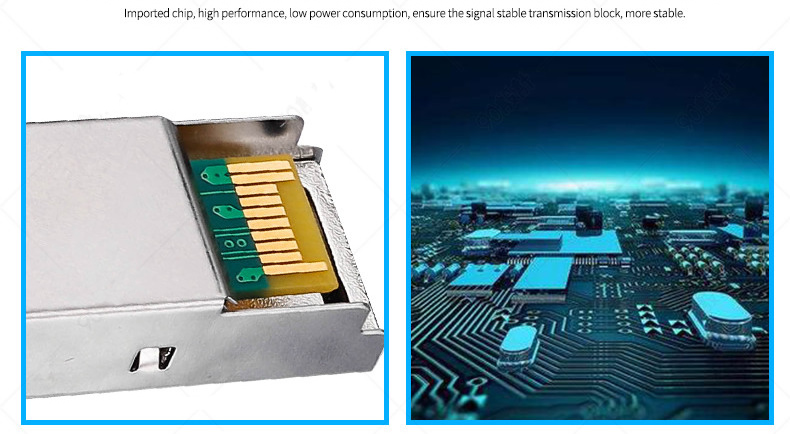For hardware development engineers, there are many important optical and electrical technical parameters for optical modules, but for the two hot-swappable optical modules GBIC and SFP, only the following three main parameters of the optical module need to be understood to carry out work smoothly:
First, the central wavelength: unit nanometer (nm), currently there are mainly 3 types:
1) 850nm (MM, multimode, low cost but short transmission distance, generally only capable of transmitting 500M);
2) 1310nm (SM, single mode, high loss but low dispersion during transmission, generally used for transmission within 40KM);
3) 1550nm (SM, single mode, low loss but high dispersion during transmission, generally used for long-distance transmission over 40KM, and can reach up to 100KM without dispersion compensation.
relay direct transmission of 120KM);
Second, transmission rate: refers to the number of bits (bit) transmitted per second, with the unit of bps. Currently, there are four commonly used types: 155Mbps,
1.25Gbps, 2.5Gbps, 10Gbps, etc. The transmission rate is generally downward compatible, so the 155M optical module is also called FE (100M) optical module, and the 1.25G optical module is also called GE (1000M) optical module. This is the most widely used module in optical transmission equipment. In addition, in the optical storage system (SAN), its transmission rate is 2Gbps, 4Gbps and 8Gbps;
Third, transmission distance: refers to the distance that optical signals can be directly transmitted without relay amplification, with the unit of kilometers (also known as kilometers, km), optical mode
The block generally has the following specifications: multimode 550m, single mode 15km, 40km, 80km, 120km, etc. For details, see the first item.

Other concepts of optical module:
In addition to the three main technical parameters mentioned above, there are several basic concepts that need to be understood in order to use optical modules:
1) Laser type: Laser is the core component of optical modules. It injects current into semiconductor materials, and emits laser light through photon oscillation and gain in the resonant cavity. Currently, the most commonly used lasers are FP and DFB lasers, which differ in semiconductor materials and resonant cavity structures. DFB lasers are much more expensive than FP lasers. Optical modules with transmission distances of up to 40KM generally use FP lasers; optical modules with transmission distances of ≥40KM generally use DFB lasers;
Loss and dispersion: Loss is the loss of optical energy due to absorption, scattering, and leakage of the medium during the transmission of light in optical fibers. This energy dissipates at a certain rate as the transmission distance increases. The generation of dispersion is mainly due to the unequal speed of electromagnetic waves with different wavelengths propagating in the same medium, resulting in different wavelength components of optical signals arriving at the receiving end at different times due to the accumulation of transmission distance, causing pulse broadening and thus making it impossible to distinguish signal values. These two parameters mainly affect the transmission distance of optical modules. In practical applications, 1310nm optical modules generally calculate link loss at 0.35dBm/km, and 1550nm optical modules generally calculate link loss at 0.20dBm/km. The calculation of dispersion values is very complex and is generally used for reference only;
3) Transmitted optical power and receiving sensitivity: Transmitted optical power refers to the output optical power of the light source at the transmitting end of the optical module, and receiving sensitivity refers to the minimum received optical power of the optical module at a certain rate and bit error rate. The units of these two parameters are dBm (meaning decibel milliwatts, the logarithmic form of the power unit mw, calculated as 10 lg, 1mw converted to 0dBm), which are mainly used to define the transmission distance of the product. The optical transmission power and receiving sensitivity of optical modules with different wavelengths, transmission rates, and transmission distances will vary, as long as the transmission distance can be ensured;
4) Service life of optical modules: international standard, 50,000 hours of uninterrupted work for 7Х24 hours (equivalent to 5 years);
5) Optical fiber interface: SFP optical modules are all LC interfaces, GBIC optical modules are all SC interfaces, and other interfaces include FC and ST, etc.;
6) Operating temperature: 0~+70℃; storage temperature: -45~+80℃; operating voltage: 3.3V; operating level: TTL/PECL/CML/LVDS.
Related content:
Internet of Things Module - Understanding Fiber Optic Modules
Huawei will launch 5G IoT modules, and Industry 4.0 will become a reality
Optical module - SFP optical module
Schematic diagram and driver program of hx711 module
What technologies are used to implement the various modules of MVC?
If you have any different opinions or suggestions, please leave a message to discuss.


